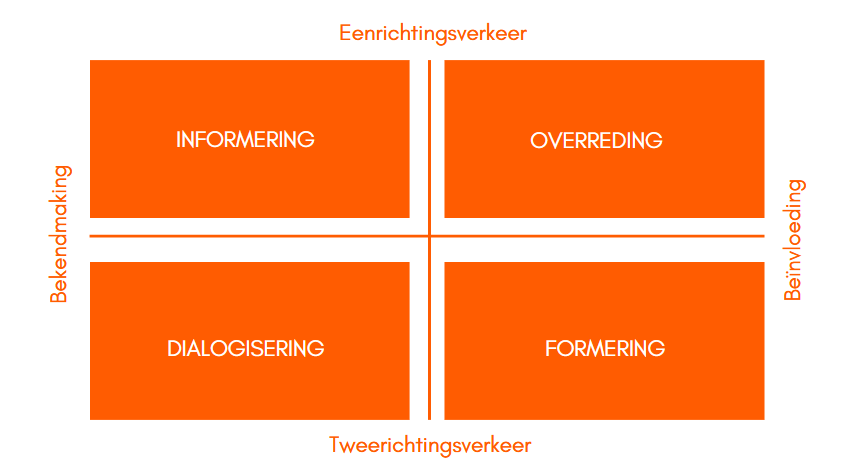As an organization, entrepreneur or professional, a good reputation is important for the reliability of your brand. You can achieve a good offline and online reputation by, among other things, investing heavily in communication.
Without knowledge or experience, it can be difficult to use a good communication mix between message and resources. For that reason, it is also wise to learn more about communication models.
In this article we take a closer look at Betteke van Ruler's communication crossroads.
The power of Betteke van Ruler's communication crossroads
An important model that helps you determine your communication strategy is Betteke van Ruler's communication crossroads. Before you set up a campaign, you actually need to answer two questions:
- To what extent do you want to influence the recipient?
- Should the recipient be able to respond or exert influence?
Depending on the answer to those questions, choose one of the communication strategies below.
 1. Inform
1. Inform
In this strategy, information is primarily central. This means that the message must be conveyed to the audience as best as possible.
The approach is based on a specific target group. The idea is that the sender makes the message known. There is no interaction with this form of information transfer. You hope that this will make people think, or, for example, provide information that will help them make a better decision.
2. Persuade
With persuasion or persuasion as a communication strategy, you want to influence people, but you do not really want to interact. The message must not only be informative but it must also convince people to do something. This involves influencing the knowledge, attitude or behavior of your target group.
Throughout history, many experts have focused on persuasive communication. In ancient Greece, philosophers were already working on rhetoric.
The advantage of our time is that you have more resources to convince your audience. You can send one-sided messages in different ways. You can do this, for example, through social media, but also through blogs on your website.
Also read: the persuasion model.
3. Dialogize
With dialogue, the focus is on interactive communication, you engage in conversation with your target group. There is interaction, so it is two-way traffic.
This strategy is aimed at identifying the wishes of the target group and taking them into account. For example, you can map opinions. What does the target group think of the company and its services?
This communication strategy works well when interactive decision-making is required and, for example, broader support is needed for certain decisions.
4. Forming
Forming goes one step further. This involves talking to your target group, but you also have the underlying desire to influence that target group.
Lobbying is a good example of formation. Forming often works well in conflict situations where it is important to maintain dialogue with each other and ultimately you want to persuade the other party to go along with your interests.
The benefits of using a communication model
In short, by working with a communication model, you think carefully in advance about the sender, the message, the means you use and the recipient.
Building lasting relationships
If you think carefully and make smart choices using a communication model, you are more likely to build a lasting relationship with your target group. The digital world ensures that certain communication strategies are no longer effective. In the past there was only mass communication. For example, a company advertised via TV or a newspaper.
The media landscape has now become so fragmented and some target groups are much more difficult to segment and reach. Thinking carefully about what exactly you want to convey, to whom, and researching where that target group is located so that you can use the right channel, is therefore essential at this time.
Specific models provide specific results
Another advantage of communication models is that they are defined. They all have specific functions and can therefore be used effectively depending on your goal. There are different forms of communication and each form has its 'rules'.
Also see:
Need help choosing a communication strategy?
Do you need help with your communication or campaign? Then take Contact contact us, we are happy to help you!

